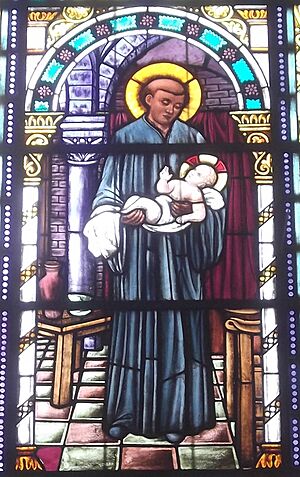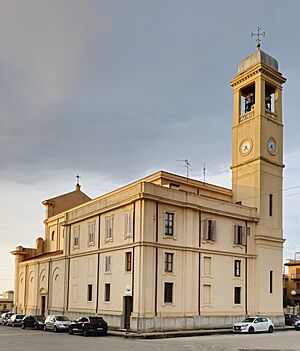Benedict the Moor facts for kids
Quick facts for kids SaintBenedict of Palermo OFM |
|
|---|---|

Stained glass of Saint Benedict the Moor, inside of the Capela do Divino Espírito Santo, Porto Alegre, Brazil.
|
|
| Religious and confessor | |
| Born | 1526 San Fratello, Messina, Sicily, Crown of Aragon |
| Died | 4 April 1589 (aged 62–63) Palermo, Sicily, Crown of Aragon |
| Venerated in | Catholic Church (Sicily and the Franciscan Order) Lutheranism |
| Beatified | 1734 by Pope Benedict XIV |
| Canonized | 24 May 1807 by Pope Pius VII |
| Major shrine | Convent of Santa Maria di Gesù al Capo, Palermo, Italy |
| Feast | 4 April (3 April in the Franciscan Order) |
| Patronage | African missions; African Americans; black missions; black people; Palermo; San Fratello; Acquedolci; Sicily |
Benedict the Moor (born in 1526, died on April 4, 1589) was a Franciscan friar from Sicily. He was born in San Fratello to parents who had been enslaved. However, Benedict was given his freedom at birth. He became well-known for his kindness and for helping others.
When he was a young man, Benedict joined a group of hermits who followed the rules of Francis of Assisi. He later became their leader. In 1564, he moved to a Franciscan friary (a home for friars) in Palermo. There, he continued his good deeds. Benedict passed away in 1589. He was later recognized as a Catholic saint by Pope Pius VII in 1807.
Contents
The Life of Saint Benedict the Moor
Benedict was born to Cristoforo and Diana Manasseri. His parents were originally from Africa. They were brought to San Fratello, a small town in Sicily, as enslaved people in the early 1500s. They were given Italian names and later became Christians.
Benedict's parents were granted freedom for their son before he was born. This was a reward for their loyal service. Like many people in his time, Benedict did not go to school and could not read or write. As a young boy, he worked as a shepherd. He was always quick to share what he earned with people who were poor.
Joining the Hermits
When Benedict was 21, some people made fun of him because of his skin color. He handled this with great patience. The leader of a group of hermits noticed his calm reaction. These hermits lived on a nearby mountain called Monte Pellegrino. They followed a simple way of life, like Francis of Assisi.
Benedict was invited to join their community. Soon after, he gave away all his belongings and became a hermit. He worked as the cook for the group. When he was 28, he became the leader of the hermits.
Becoming a Franciscan Friar
In 1564, Pope Pius IV asked independent groups of hermits to join larger religious orders. Benedict's group joined the Order of Friars Minor, also known as the Franciscans. Benedict was then sent to the Franciscan Friary of St. Mary of Jesus in Palermo.
He started working in the friary kitchen as a cook. But because of his strong spiritual life, he was soon given more important roles. He became the master of novices, teaching new friars. Later, he became the Guardian of the community, which is like a leader. This was special because he was a lay brother (not a priest) and could not read.
Benedict took on these leadership roles and helped the Franciscans follow their rules more strictly. People respected him for his deep understanding of theology (the study of religious faith) and Scripture (holy writings). Many people came to him for advice. He also had a reputation for healing sick people. In his later years, he went back to cooking, which he enjoyed.
His Passing
Benedict passed away at the age of 65. It is said that he knew the exact day and time he would die. At the entrance to his room in the friary, there is a plaque. It says, "This is the cell where Saint Benedict lived," and lists his birth and death dates. While some sources say he was born in 1524, most agree on 1526.
After his death, King Philip III of Spain ordered a beautiful tomb to be built for Benedict's remains. This tomb was placed in the friary church.
Honoring Saint Benedict
Benedict was honored as "Blessed" by Pope Benedict XIV in 1743. He was then made a saint by Pope Pius VII in 1807. It is believed that when his body was later moved, it was found to be "incorrupt," meaning it had not decayed. His main shrine was at the Convent of Santa Maria di Gesù al Capo in Palermo. Sadly, the church and his relics were largely damaged during wildfires in 2023.
Benedict is remembered for his great patience and understanding. He showed these qualities even when people were prejudiced against him or made fun of him. He is considered a patron saint of African Americans, along with Martin de Porres.
Many Catholic churches in the United States are named after Saint Benedict the Moor. Here are some examples:
| Parish name | Diocese | Location | Established |
|---|---|---|---|
| St. Benedict the Moor | Archdiocese of Washington | Washington, D.C., USA | 1946 |
| St. Benedict the Moor | Archdiocese of New York | New York City, USA | |
| St. Benedict the Moor | Archdiocese of Kingston | Bull Bay, Jamaica | |
| St. Benedict the Moor | Archdiocese of Cincinnati | West Dayton, Dayton, Ohio, USA | 2005/2020 |
| St. Bonaventure - St. Benedict the Moor | Diocese of Brooklyn | Jamaica, Queens, New York City, USA | 1932 |
| St. Benedict the Moor parish | Diocese of Pittsburgh | Pittsburgh, USA | 1889/2020 |
| St. Benedict the African parish | Archdiocese of Chicago | Englewood, Chicago, USA | 1989/2016 |
| St. Benedict The Black | Diocese of Shreveport | Grambling, Louisiana, USA | |
| St. Benedict the Moor, Bertrandville | Diocese of Baton Rouge | Bertrandville, Louisiana, USA | 1911 |
| St Benedict the Moor, Savannah | Diocese of Savannah | Savannah, Georgia, USA | 1888 |
The St. Benedict the Moor Catholic Church in Savannah, Georgia, was founded in 1874. It is one of the oldest Catholic churches for African Americans in the southeastern United States. Churches named after him have also been started in Columbus, Georgia and St. Augustine, Florida.
People also honor Saint Benedict throughout Latin America, from Mexico to Argentina. In Venezuela, his devotion is very popular. He is celebrated on different dates there, depending on local traditions.

See also
- List of Catholic saints
- Incorruptibility

